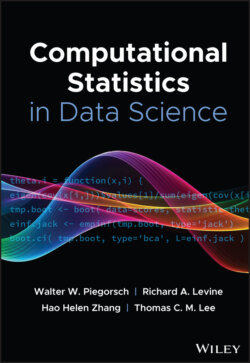Читать книгу Computational Statistics in Data Science - Группа авторов - Страница 129
5 Stopping Rules
ОглавлениеMonte Carlo simulations are often terminated according to a fixed‐time regime. That is, before the start of the simulation, it is decided that some steps of the process will be generated. The fixed‐time termination rule may be formally written as
(5)
By construction, , and simulation terminates when the criterion is met. The representation in Equation (5) allows further adjustments to our termination rule with an ‐fixed‐time approach, where for some , the simulation terminates at
(6)
The termination time is deterministically dependent on . Specifically, . Glynn and Whitt [29] show that as . However, since the structure of the underlying distribution and the quantity of interest are unknown, there is often little intuition as to what and should be for any given problem.
Alternatively, one could terminate according to a random‐time regime such as when the volume of a confidence region (possibly relative to some quantity) is below a prespecified threshold. These confidence region volumes, , could be either at Equation (2) or at Equation (3). Glynn and Whitt [29] and Vats et al. [26] show that the resulting confidence regions created at termination have the correct coverage, asymptotically. Since the simulation ends at a random time, the estimate of the limiting Monte Carlo variance–covariance matrix, used in construction of , is required to be strongly consistent. Glynn and Whitt [29] further show that weak consistency is not sufficient. We discuss stopping rules of this type for IID and MCMC sampling in the following sections.
